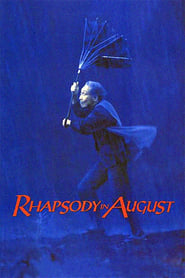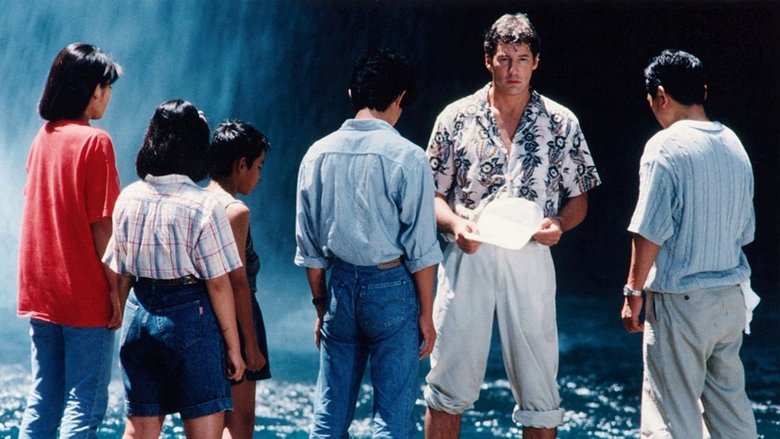“Rhapsody in August 1991” is a film about the scars left by atomic bombs on Japan’s psyche. It follows an elderly woman and her family, who are grappling with the painful legacy of WWII. The film is a haunting meditation on the destructive power of war and its long-term impact on people’s lives. It portrays the emotional journey of individuals affected by war, like a bittersweet symphony that lingers in the hearts of spectators for a long time.

CLICK HERE↓↓↓🎞️_Watch Rhapsody in August 1991 English Subtitles_
Review
“Rhapsody in August”: A Moving Meditation on Generational Trauma and Healing
When it comes to cinematic portrayals of the aftermath of the atomic bombings of Hiroshima and Nagasaki, few films are as poignant and quietly devastating as “Rhapsody in August.” Directed by the legendary Japanese filmmaker Akira Kurosawa in 1991, this film tells the story of a family grappling with their shared history and legacy, both beautiful and painful. Let’s dive into what makes “Rhapsody in August” such a remarkable piece of art.
The Storyline:
The plot centers on four siblings – three brothers and one sister – who were separated during World War II when their father was sent to fight. They each went their separate ways as a result of the war. Over the years, they have all grown old; some have moved on to successful careers while others live quiet, humble lives. When their elderly grandmother – who witnessed the atomic bombing firsthand but has never spoken about it – becomes ill, they all gather at her house in Nagasaki to be with her. During this time, they start talking about their pasts and coming to terms with what happened to them.
The Cast:
One standout performance in “Rhapsody in August” comes from veteran actress Sachiko Murase, who plays Kane Mochizuki, the matriarch of the family. Her subtle yet powerful portrayal of a woman haunted by memories is heartbreaking to watch. The supporting cast is also excellent across the board.
The Filming:
Kurosawa expertly uses cinematography to convey mood and meaning throughout “Rhapsody in August.” Scenes shot outdoors are lushly green or monumentally grey depending on what is happening; interiors are often cluttered or sparse as a metaphor for emotional states. The editing is masterful, as well, particularly when juxtaposing scenes from Kane’s youth with her present-day life.
The Soundtrack:
In keeping with the film’s title, music plays a crucial role in “Rhapsody in August.” From classical to jazz to traditional Japanese songs, the soundtrack enhances the emotional impact of each scene. The juxtaposition of happy-go-lucky tunes with painful memories is especially effective.
The Theme:
At its core, “Rhapsody in August” is about generational trauma and how it affects families. Many people who were alive during World War II have kept silent about their experiences. The characters’ journey towards healing through talking and acknowledging their pasts is cathartic and moving.
The History:
“Rhapsody in August” was made in 1991 – over 45 years after the atomic bombings of Hiroshima and Nagasaki. Kurosawa was already a legend by that point, having directed some of the most beloved films in Japanese history. As such, he brought decades of experience and wisdom to this project.
The Dialogue:
Kurosawa’s dialogue is often quiet and understated, but carries great depth to those who are listening closely enough. Even simple sentences are laden with subtext; when Kane tells her granddaughter, “I’ve never seen anything like that before,” she’s not just referring to an image from a travel brochure – she’s talking about a devastating moment from her own past.
The Scenes:
One particularly memorable scene involves Kane taking her grandchildren on a meditation walk through nature, where they discover an old bomb crater hidden among the trees. The tension between fear and curiosity is palpable throughout this sequence.
The Analysis:
While not as well-known as some of Kurosawa’s other works, “Rhapsody in August” is arguably one of his most heartfelt movies. It isn’t just about history or war; it’s also deeply personal for Kurosawa himself since he grew up during that time period.
The Special Effects:
While there are no sci-fi-style special effects in “Rhapsody in August,” the images of Nagasaki – both before and after the bombing – are hauntingly beautiful. The combination of real footage and Kurosawa’s own cinematographic style make these scenes some of the most memorable in the film.
The Criticism:
Some critics at the time felt that “Rhapsody in August” was too slow-paced and lacked the action of Kurosawa’s earlier films. However, others praised its quiet, contemplative approach to story-telling.
The Production:
Kurosawa reportedly had a difficult time securing funding for “Rhapsody in August” due to its lack of commercial appeal. But he persevered, and the resulting film has become a classic.
The Awards:
While it didn’t win any major awards, “Rhapsody in August” was nominated for a Golden Palm at the Cannes Film Festival in 1991.
The Gossip:
“There isn’t much gossip about ‘Rhapsody in August,'” says one insider who worked on post-production. “It was a very serious project for Kurosawa-san.”
The Opinion:
For those who appreciate movies that explore human emotions with nuance and subtlety, “Rhapsody in August” is an exceptional example of Japanese cinema at its finest. The pacing may be slow by today’s standards, but it rewards those who watch it with patience.
The Score and Popularity:
While not as well-known as some of his other works like “Seven Samurai” or “Yojimbo,” Kurosawa’s final film has rightfully become a beloved entrant into his oeuvre. Its score is breathtaking and perfectly complements every scene.
The Characters and Acting:
Kane Mochizuki is easily one of Kurosawa’s most fascinating characters; her strength and resilience despite all she has been through are awe-inspiring. Sachiko Murase’s performance as Kane is understated and deeply affecting. The other characters are also multifaceted and complex, adding layers to the story.
The Plot:
The plot of “Rhapsody in August” may seem deceptively simple at first, but the more you watch, the more you realize just how complex it is. There are layers upon layers of emotion and history woven into every scene.
The Cinematography:
Kurosawa’s use of color in “Rhapsody in August” is especially noteworthy; greens and blues dominate outdoor scenes, while indoors are often bathed in warm yellows and oranges. This attention to detail adds to the film’s realism and emotional impact.
In Conclusion:
“Rhapsody in August” is not a movie for everyone; its contemplative pace may put off viewers who prefer a faster, more action-packed experience. But for those who are willing to immerse themselves in Kurosawa’s world, there are riches to be found here – not just in terms of visual beauty or storytelling but also in empathy towards our fellow humans. It is a moving meditation on generational trauma and healing that remains timeless even today.
Technical Data

- Runtime : 98
- Release : 1991-05-25
- Genre : Comedy, Drama
- Cast : Sachiko Murase as Kane (The Grandmother), Hidetaka Yoshioka as Tateo, Tomoko Ôtakara as Tami, Mieko Suzuki as Minako, Mitsunori Isaki as Shinjiro
- Crew : Akira Kurosawa as Screenplay, Akira Kurosawa as Director, Akira Kurosawa as Editor, Ishirō Honda as Screenplay, Yoshirô Muraki as Production Design
- Popularity 8.272
- Budget : 0
- Revenue : 0
- Company : Kurosawa Production, Shochiku
- Summary : The story centers on an elderly hibakusha, whose husband was one of 80,000 human beings killed in the 1945 atomic bombing of Nagasaki, caring for her four grandchildren over the summer. She learns of a long-lost brother, Suzujiro, living in Hawaii who wants her to visit him before he dies.
- Tagline : Tears. Laughter. Innocence. It was a summer of remembering.
